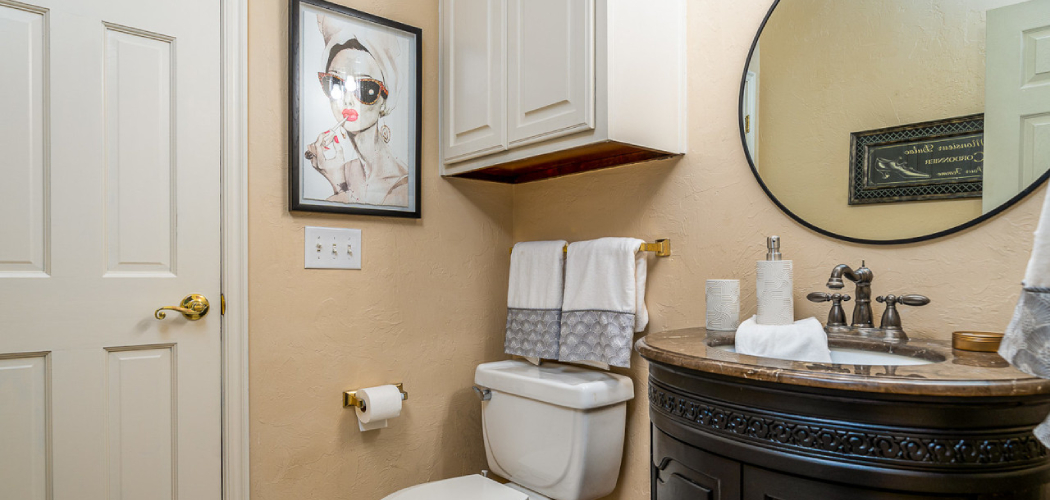Discovering black spots on your bathroom mirror can be frustrating and unsightly, but fortunately, there are effective solutions to address this common issue. Black spots on a bathroom mirror are typically caused by the deterioration of the mirror’s silver backing due to moisture exposure over time.
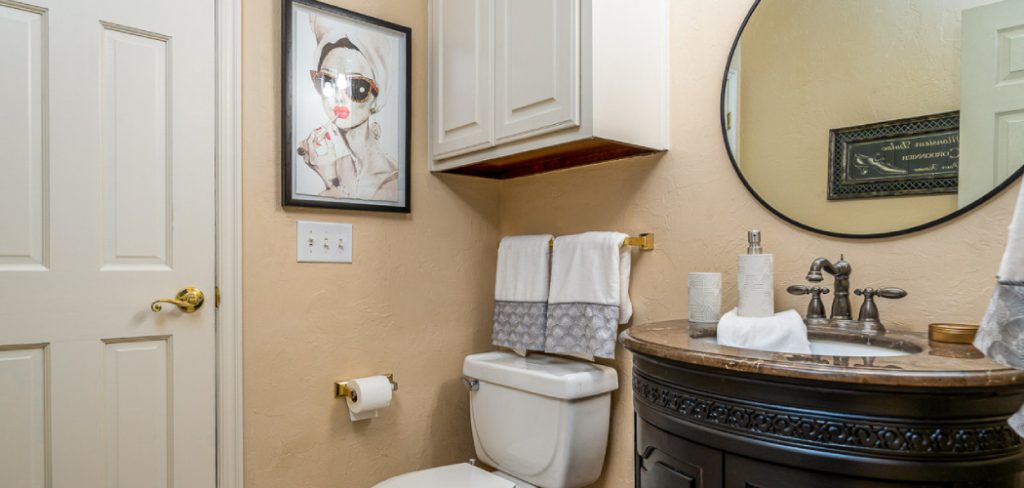
These spots can detract from the mirror’s clarity and aesthetics, affecting the overall appearance of your bathroom. In this guide, we’ll explore various methods for how to fix black spots on bathroom mirror and restore their pristine condition.
From simple DIY remedies to professional restoration techniques, we’ll provide comprehensive instructions to help you eliminate black spots and achieve a clear, reflective surface once again. Say goodbye to those pesky black spots and enjoy a sparkling mirror that enhances the beauty of your bathroom.
Importance of a Clean and Clear Bathroom Mirror
A clean and clear bathroom mirror is more than just a reflective surface; it’s a vital component of your bathroom’s aesthetics and functionality. Firstly, a spotless mirror contributes significantly to the overall cleanliness and appeal of the bathroom, creating a more inviting and comfortable space.
Additionally, a clear mirror is essential for many daily grooming activities, such as shaving, applying makeup, or styling hair. These tasks require precise visibility, which can only be achieved with a mirror free of blemishes, including black spots or streaks. Furthermore, mirrors play a crucial role in enhancing the perceived space and lighting of a bathroom.
A well-maintained mirror reflects light efficiently, contributing to a brighter and more spacious feeling room. Therefore, keeping bathroom mirrors clean and clear not only serves practical purposes but also elevates the room’s ambiance, making it a more pleasant environment for all who use it.
Causes of Black Spots on Mirrors
The appearance of black spots on bathroom mirrors is a common problem that can often be attributed to a few key factors. One of the primary causes is moisture exposure. Bathrooms are typically high-humidity environments, and when moisture consistently comes into contact with the mirror, especially around its edges, it can start to degrade the reflective silver layer beneath the glass. Over time, this degradation leads to the formation of black spots.
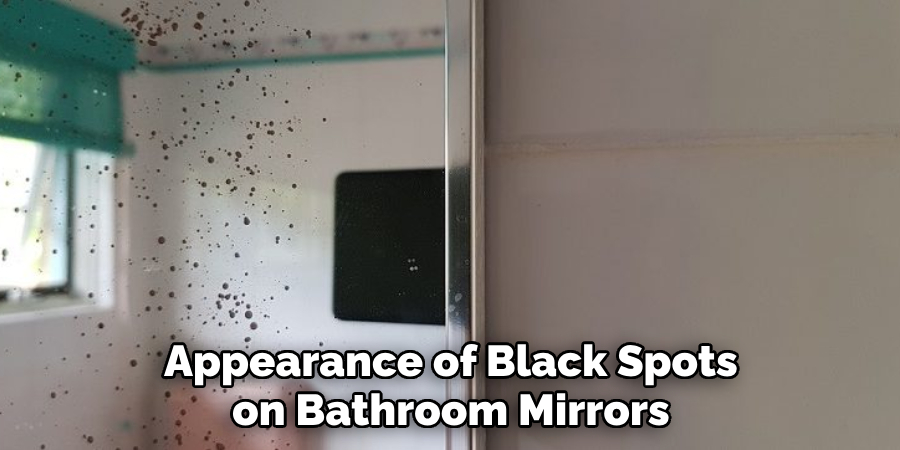
Another contributing factor is the quality of the mirror itself. Mirrors with a thin or poor-quality silver or reflective coating are more prone to developing black spots, as these coatings can be more easily damaged by environmental factors, such as high humidity or direct contact with water.
Prevention and Maintenance Tips
Preventing black spots on bathroom mirrors primarily involves controlling moisture exposure, careful cleaning, and proper maintenance. Here are some practical tips to help keep your mirror in its best condition:
- Ensure Good Ventilation: Keeping your bathroom well-ventilated reduces moisture buildup. Utilize an exhaust fan during and after showers and baths to expel moist air out of the space.
- Use a Microfiber Cloth: When cleaning the mirror, always use a soft, microfiber cloth to avoid scratching the surface which can lead to further damage.
- Avoid Harsh Chemicals: Stick to mild cleaning solutions specifically designed for mirrors or glass. Harsh chemicals can strip away protective coatings, making the mirror more vulnerable to black spots.
- Seal the Edges: Consider applying a sealant around the edges of the mirror. This can prevent moisture from seeping underneath and damaging the silver backing.
- Regular Checks and Maintenance: Regularly inspect the edges and back of the mirror for signs of wear or moisture damage. Early detection can lead to more effective prevention methods or repairs.
- Professional Help: For valuable or antique mirrors showing signs of black spots, consult with a professional restorer who can offer specialized advice and services.
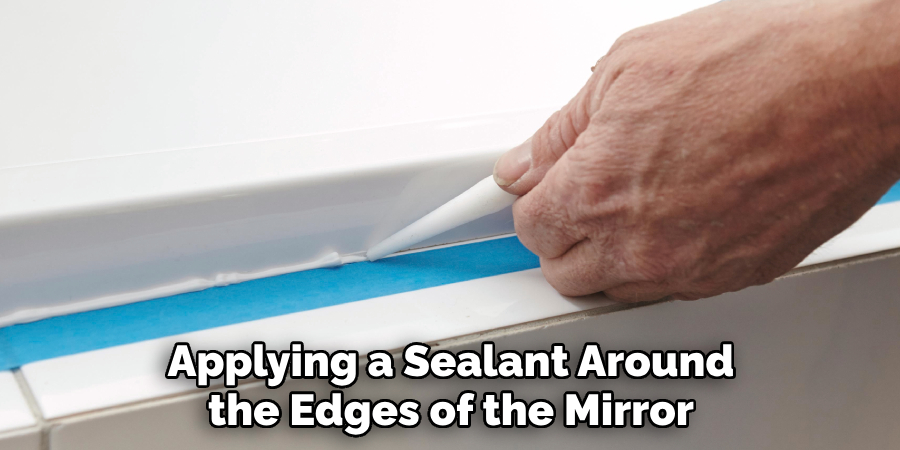
Battling Mold and Mildew
Mold and mildew buildup is yet another consequence of the excess moisture prevalent in bathroom environments. These fungi thrive in warm, damp conditions and can often be found proliferating around the bathroom, including on walls, ceilings, and even on the mirror itself.
Besides being unsightly, mold and mildew can pose health risks, especially to individuals with allergies or respiratory problems. Addressing mold and mildew is crucial not just for the cleanliness and aesthetics of your bathroom, but also for the health and safety of your household.
Preventing mold and mildew involves similar strategies to preventing black spots on mirrors, with an emphasis on moisture control. Regular cleaning with mild, non-abrasive cleaners can keep mold spores at bay, while ensuring adequate ventilation helps to dry out potential breeding grounds for these fungi.
Additionally, consider using mold-resistant paint in areas prone to moisture and cleaning solutions specifically designed to combat mold and mildew. Tackling mold and mildew early and preventing their growth is key to maintaining a healthy and pristine bathroom environment.
Hard Water Stains from Mineral Deposits
Just as black spots and mold present challenges in bathroom maintenance, hard water stains from mineral deposits are another common issue that can detract from the cleanliness and appearance of your bathroom fixtures, including faucets, tiles, and shower doors.
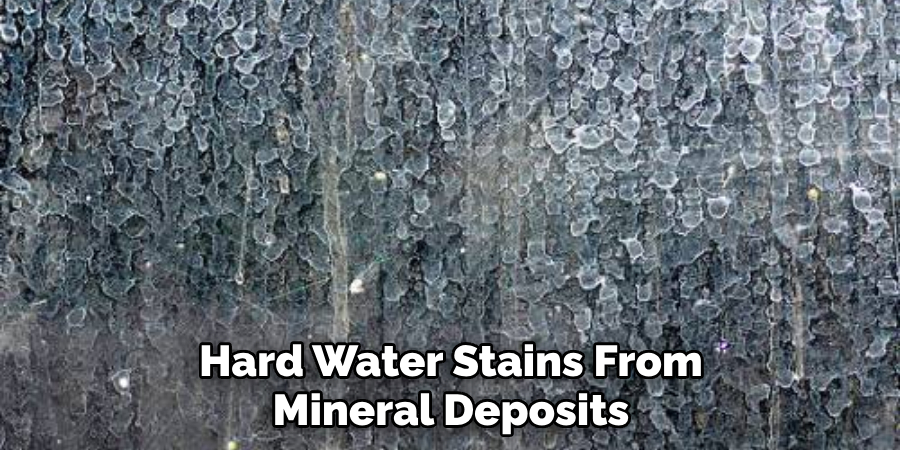
These stains are primarily caused by water that has a high mineral content, commonly calcium and magnesium, which leaves behind a residue when it evaporates. Over time, this residue builds up, creating stubborn, chalky spots that are not only unattractive but can also be challenging to remove.
Preventing hard water stains involves a proactive approach to water management and regular cleaning. Here are some effective strategies to consider:
- Use a Water Softener: Installing a water softener in your home can significantly reduce the mineral content in your water, thereby minimizing the formation of hard water stains.
- Daily Wiping: After using the shower or bath, take a moment to wipe down the surfaces with a squeegee or a soft cloth. This simple action can prevent water droplets from evaporating on the surface and leaving mineral deposits behind.
- Vinegar Solution: For a natural cleaning solution, mix equal parts white vinegar and water in a spray bottle. Vinegar is an effective, natural acid that can break down mineral deposits. Spray it on the affected areas, leave it for a few minutes, then scrub gently with a soft brush or cloth before rinsing off.
- Regular Cleaning Routine: Incorporate the cleaning of hard water stains into your regular bathroom maintenance schedule. The longer the stains are left untreated, the more difficult they will be to remove.
- Protective Coatings: Applying a protective coating or sealant specifically designed for bathroom fixtures and tiles can create a barrier that water droplets cannot penetrate, thus reducing the likelihood of stain formation.
Residue from Beauty or Cleaning Products
The accumulation of residue from beauty or cleaning products is a pervasive issue that can impact various surfaces in the bathroom, including mirrors, countertops, and sink basins. These products, ranging from hairspray and lotions to bleach-based cleaners, often leave behind a film or deposits that can dull the appearance of surfaces and create a breeding ground for bacteria.
To combat this problem, it’s essential to adopt a meticulous cleaning routine that targets these residues specifically. Here are some strategies to keep in mind:
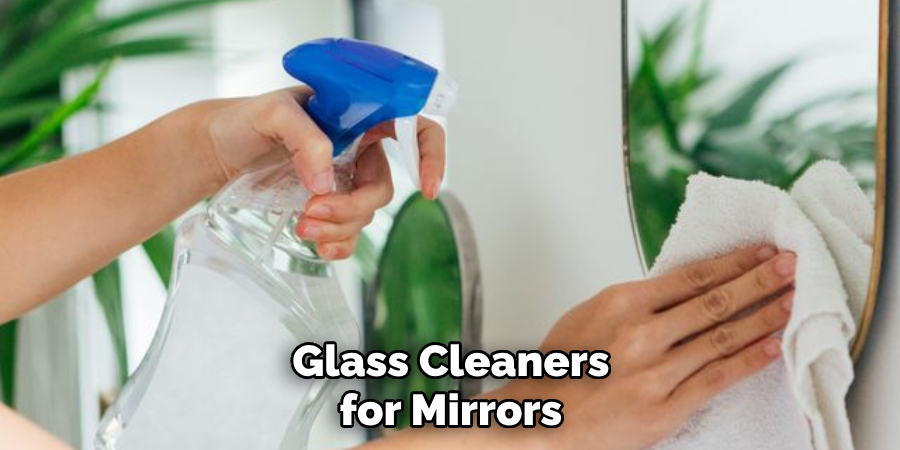
- Immediate Wiping: After the application of beauty products such as hairspray or face creams, immediately wipe down any surfaces that may have been inadvertently sprayed or touched. This prevents the product from settling and becoming harder to remove later.
- Appropriate Cleaners: Use cleaners designed for the specific surface you are cleaning. For example, glass cleaners for mirrors and disinfectant wipes for countertops. This ensures that the residue is effectively removed without damaging the surface.
- DIY Solutions: For a cost-effective and gentle cleaning option, consider homemade solutions like a mixture of baking soda and water for scrubbing or diluted vinegar for glass surfaces. These natural cleaners can effectively break down residue without harsh chemicals.
- Regular Deep Cleaning: Incorporate a regular deep-cleaning session into your routine, focusing on areas that are frequently exposed to beauty and cleaning products. This helps prevent the buildup of residue over time.
- Proper Storage: Store beauty and cleaning products in closed cabinets or organizers to minimize accidental spills and sprays onto surrounding surfaces.
10 Methods How to Fix Black Spots on Bathroom Mirror
1. Cleaning with Vinegar Solution:
Start by creating a solution of equal parts white vinegar and water in a spray bottle. Spray the solution onto the affected areas of the mirror and let it sit for a few minutes. Then, use a soft microfiber cloth to gently wipe the spots in a circular motion. Vinegar’s acidic properties can help dissolve and remove some of the black spots caused by mineral deposits or other residues.
2. Polishing with Toothpaste:
Toothpaste contains mild abrasives that can help polish away minor black spots on a bathroom mirror. Apply a small amount of non-gel toothpaste to a soft cloth and rub it onto the affected areas in a circular motion. Rinse the mirror thoroughly with water and dry it with a clean cloth. This method can be effective for removing light stains and restoring shine to the mirror’s surface.
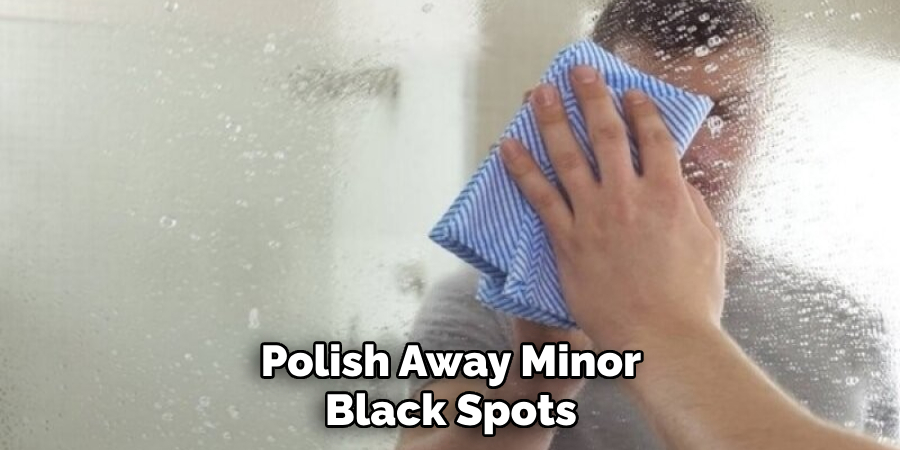
3. Using Rubbing Alcohol:
Rubbing alcohol is another effective solvent for removing black spots on a bathroom mirror. Apply a small amount of rubbing alcohol to a clean cloth and gently rub it onto the affected areas. The alcohol helps dissolve and lift away any residue or buildup causing the black spots. Afterward, rinse the mirror with water and dry it thoroughly to prevent streaking.
4. Applying Ammonia Solution:
Ammonia is a powerful cleaning agent that can effectively remove stubborn black spots on a bathroom mirror. Mix one part household ammonia with two parts water in a spray bottle. Spray the solution onto the affected areas of the mirror and let it sit for a few minutes. Then, wipe the mirror clean with a soft cloth. Be sure to ventilate the area well while using ammonia and avoid inhaling the fumes.
5. Using Commercial Mirror Cleaner:
Commercial mirror cleaners are specifically formulated to remove dirt, grime, and stains from mirrors effectively. Choose a high-quality mirror cleaner from your local hardware or home improvement store and follow the manufacturer’s instructions for use. Spray the cleaner onto the black spots on the mirror and wipe it clean with a soft cloth or paper towel. Repeat as necessary until the spots are removed.
6. Buffing with Baking Soda Paste:
Baking soda is a gentle abrasive that can help buff away black spots on a bathroom mirror. Mix a paste of baking soda and water until it forms a thick consistency. Apply the paste to the affected areas of the mirror and use a soft cloth to buff them in a circular motion. Rinse the mirror with water and dry it thoroughly to reveal a clean, spot-free surface.
7. Removing with Lemon Juice:
Lemon juice contains natural acids that can help dissolve and remove black spots on a bathroom mirror. Squeeze fresh lemon juice onto a clean cloth and rub it onto the affected areas of the mirror. Let the juice sit for a few minutes before wiping it clean with a damp cloth. Lemon juice not only removes black spots but also leaves behind a fresh, citrus scent.
8. Using Hydrogen Peroxide Solution:
Hydrogen peroxide is a mild bleaching agent that can effectively lighten and remove black spots on a bathroom mirror. Mix equal parts hydrogen peroxide and water in a spray bottle and spray the solution onto the affected areas. Allow it to sit for a few minutes before wiping the mirror clean with a soft cloth. Repeat the process as needed until the spots are gone.
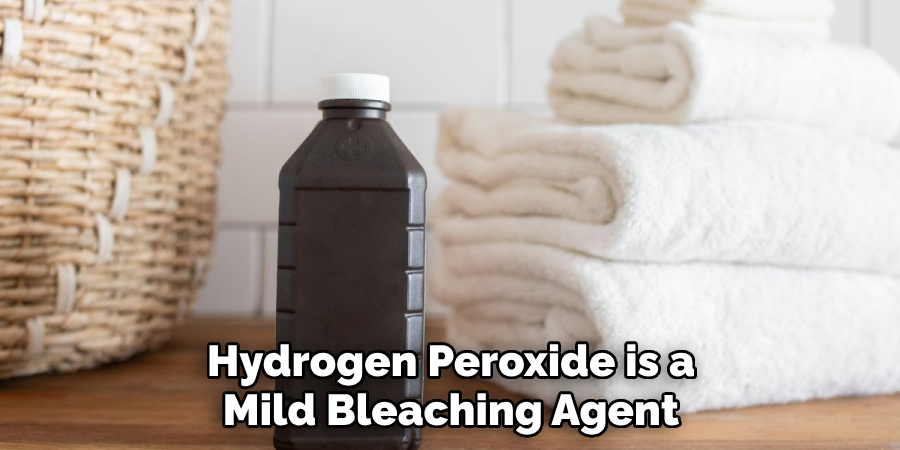
9. Applying Glass Etching Cream:
Glass etching cream can be used to remove stubborn black spots on a bathroom mirror by etching away a thin layer of the mirror’s surface. Apply the etching cream to the affected areas of the mirror using a soft brush or sponge. Follow the manufacturer’s instructions for application and safety precautions. After the specified time, rinse the mirror thoroughly with water and dry it completely.
10. Seeking Professional Restoration:
If the black spots on your bathroom mirror persist despite your best efforts, consider seeking professional restoration services. Professional glass restoration companies have specialized equipment and techniques to effectively remove stubborn stains and restore the mirror’s clarity and appearance. Contact a reputable glass restoration company in your area for a consultation and quote.
Advanced Techniques for Stubborn Stains on Bathroom Mirrors
When conventional cleaning methods fail to remove the most stubborn stains from bathroom mirrors, advanced techniques may be required. These strategies involve a more intensive cleaning approach and may require special products or tools. Before proceeding, ensure that you wear appropriate safety gear, such as gloves and goggles, to protect yourself from harsh chemicals or abrasive materials.
Utilizing Professional Grade Scouring Powders:
Professional grade scouring powders contain ingredients designed to tackle hard-to-remove stains without scratching the mirror’s surface. Dampen a soft cloth with water, sprinkle some scouring powder onto it, and gently buff the stained area in a circular motion. Rinse thoroughly with water and dry.
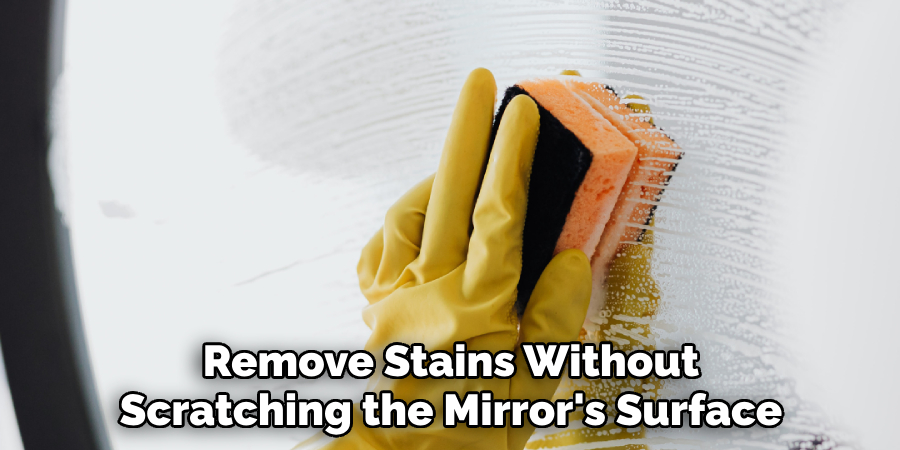
Sanding with Ultrafine Sandpaper:
For extremely persistent stains that have caused superficial damage to the mirror surface, ultrafine sandpaper (2000 grit or higher) can be used with caution. Lightly sand the affected area with minimal pressure to avoid deeper scratches or damage. This method should only be considered as a last resort, and it’s advisable to test on an inconspicuous area first.
Electrolytic Rust Removal for Metal Residues:
If the stains are a result of corrosion or rust from metal fixtures, an electrolytic rust removal process can be an effective solution. This method involves using a mild electrolyte solution and a low-voltage electrical current to carefully remove rust without damaging the mirror. It requires specific equipment and safety precautions, and it might be best suited for professionals.
Chemical Peel Cleaners:
Certain specialty cleaners offer a ‘chemical peel’ effect designed for glass surfaces. These products are applied to the stain and allowed to dry, forming a film. Once the film is peeled off, it takes with it the most stubborn stains and residues. Always follow the product instructions closely and ensure adequate ventilation in the cleaning area.
Ozone Treatment for Organic Stains:
Ozone generators can be used to treat organic stains, such as mold or mildew, that are not only surface issues but also ingrained within the porous edges of mirrors. Ozone treatment is a powerful and effective method to neutralize organic compounds but must be handled with care and preferably by professionals, to avoid adverse health effects.
Conclusion
In conclusion, addressing black spots on your bathroom mirror is essential not only for maintaining a clear reflection but also for preserving the aesthetic appeal of your bathroom. By understanding the various causes of these spots and implementing the DIY methods outlined in this guide, you can effectively remove mold, mildew, hard water stains, and residue.
Additionally, utilizing advanced techniques for stubborn stains and adopting preventative measures such as proper ventilation and regular cleaning can help prevent future black spots from forming. Thanks for reading, and we hope this has given you some inspiration on how to fix black spots on bathroom mirror!

